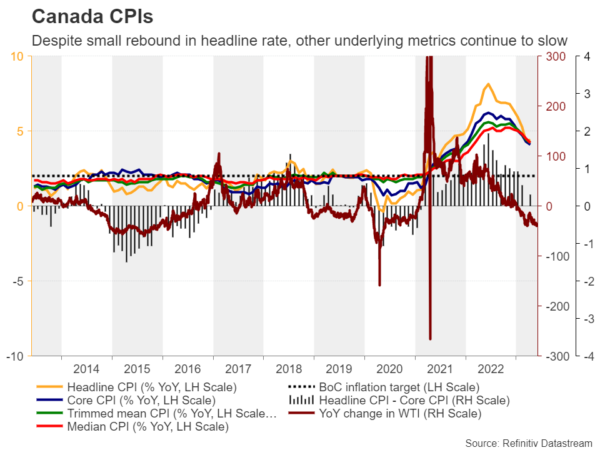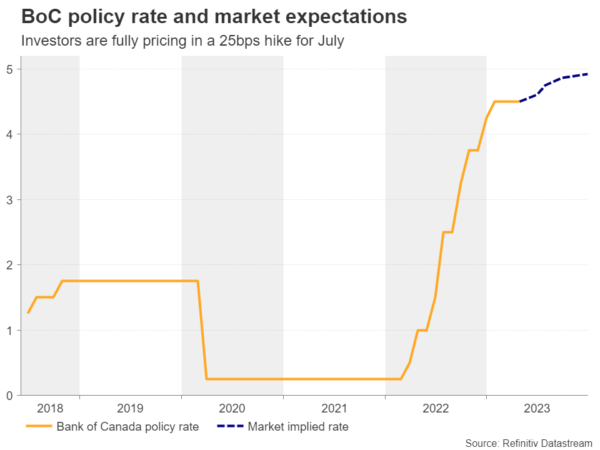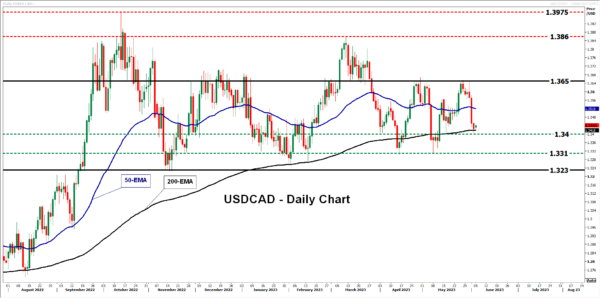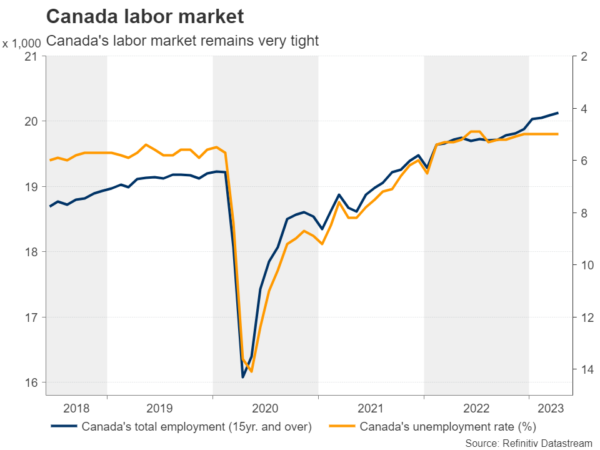After staying inactive for two consecutive meetings, the BoC is now expected by a decent percentage of market participants to raise interest rates when it meets on Wednesday at 14:00 GMT. The hype of another rate hike was bolstered by the much-better-than-expected GDP data for Q1. Will policymakers indeed press the button, or will they stay patient and wait for more incoming data before deciding whether raising interest rates further is appropriate?
Data keeps the hike door open
At its latest gathering, the Bank of Canada decided to stand pat for the second meeting in a row as it was largely anticipated. However, it did not satisfy those expecting a rate cut later this year, with the statement revealing that policymakers are still prepared to raise rates further if deemed necessary.
Data after the meeting have been adding credence to the Bank’s choice to leave the door to more hikes open. The April jobs report revealed that the unemployment rate held steady at 5.0%, just a tick above its lowest level in more than five decades, while the inflation data for the month showed that headline inflation accelerated in April, and although all the underlying metrics slowed, both the Trimmed mean and Common CPI rates slid by less than expected.
Most importantly, the economy grew by double the estimated pace during the first three months of the year after stagnating at the end of 2022, resulting in a skyrocketing quarter-on-quarter annualized rate to 3.1% from -0.1%.
But a hike more likely in July
Having said all that though, although market participants are convinced that another hike may be firmly on the table, they don’t see a high probability of this happening at this week’s gathering. They are assigning a 40% probability to the hike scenario, with the remaining 60% pointing to no action. They believe that a hike is more likely to be delivered in July and nearly another one by December.
Therefore, should policymakers stay sidelined and stick to their guns that they remain prepared to hike more if needed, the loonie is likely to slide but not much. For a noteworthy and sustained tumble in the Canadian currency, officials may need to stand pat and officially announce the end of this tightening crusade, which according to the aforementioned data appears to be the least likely scenario.
The former looks the wisest choice as it is too early to describe the latest rebound in the headline CPI rate as inflation getting out of control, and thus, officials may prefer to wait for more data before they hike again. They could do so at the July meeting, where updated macroeconomic projections will be available. Now, in the case of the Bank pressing the hike button this week and appearing willing to deliver more, the loonie could rally.
Dollar/loonie stays trapped within a wide range
Dollar/loonie has been trading in a trendless mode since November, with most of the price action being contained between the 1.3230 and 1.3650 barriers. Thus, the medium-term picture, at least from a technical perspective, looks neutral.
Currently, the pair is sitting slightly above the 1.3400 zone. If the BoC appears less hawkish than expected on Wednesday, dollar/loonie is likely to rebound and perhaps aim for another test at the upper bound of the range, at around 1.3650.
On the other hand, a potential hike could extend last week’s retreat, with a potential break below 1.3400 perhaps paving the way towards the lower bound of the aforementioned range, at around 1.3230.
Employment report also on tap
Having said all that though, apart from the BoC decision and the related market reaction, loonie traders will also have to evaluate the Canadian employment report for May, due out on Friday. Even if policymakers stay on hold, conditional upon leaving the door open to another hike, a strong employment report could prompt investors to add to their hike bets, adding more basis points worth of increments by the end of the year.
















